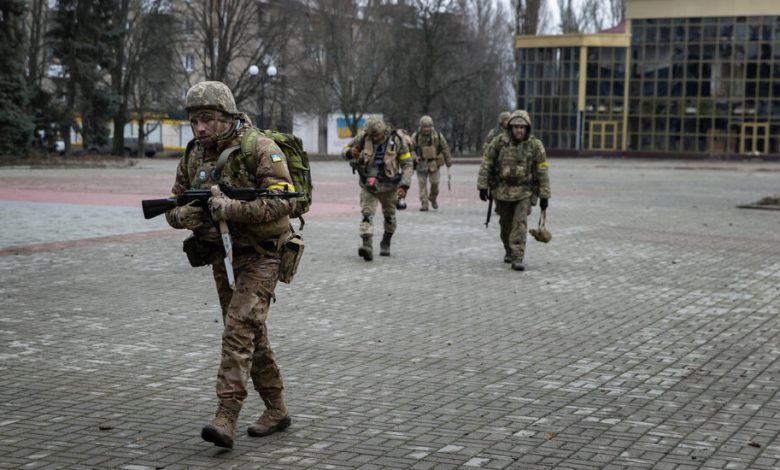Congress Proposes More Than $44 Billion for Ukraine

WASHINGTON — The giant annual spending bill unveiled by Congress on Tuesday contains more than $44 billion in emergency aid for Ukraine, renewing the U.S. commitment to the country’s defense as Russia’s invasion grinds toward a second year.
The new wave of aid for Ukraine — billions more than President Biden requested in mid-November — comes amid growing concerns among the country’s backers about the depth of America’s support. Some Republicans have questioned the massive spending, while some progressives have called for peace talks.
The aid package consists mostly of military spending, including nearly $20 billion to arm and equip Ukraine’s forces, and to replenish Defense Department stockpiles from which weapons are being sent to Kyiv. Some of that money would also be used to bolster the defenses of America’s NATO allies to protect against further Russian aggression.
Another $6.2 billion would support a surge of U.S. forces in Eastern Europe that Mr. Biden ordered after the Russian invasion, including thousands of American troops deployed to Poland and Romania.
The “omnibus” budget bill, which includes the new Ukraine aid, funds the federal government into next year to avoid a shutdown. If Congress passes it, U.S. aid to Kyiv since Russia invaded in February will amount to more than $100 billion, allocated over four emergency spending packages. Congressional leaders hope to win approval for the spending this week.
The State of the War
- A Botched Invasion: Secret battle plans, intercepts and interviews with soldiers and Kremlin confidants offer new insight into the stunning failures of Russia’s military in Ukraine.
- A New Russian Offensive? A top adviser to President Volodymyr Zelensky said Ukraine is bracing for the possibility that Russia will sharply escalate the war in a winter offensive that could include mass infantry attacks.
- Putin in Belarus: President Vladimir V. Putin of Russia made a rare visit to Belarus, raising concerns in Ukraine that Russian forces could aim again at Kyiv, which is near the Belarusian border.
- The War in the Skies: As Ukrainian officials warn of a new Russian ground offensive, waves of Russian missiles continue to batter Ukraine’s infrastructure. The attacks are leaving a trail of destruction and grief.
In what was perhaps a reflection of the enormousness of the aid package and the speed at which it was assembled, Democratic and Republican appropriators differed in their calculations of the final price tag. Democrats placed the figure at just under $45 billion, and Republicans said the total exceeded $47 billion.
U.S. assistance has been essential to Ukraine’s survival and the major blow the country has dealt to Russia’s military, which badly miscalculated how much resistance Ukraine would mount. Mr. Biden has said that the defense of Ukraine was vital to the defense of democracy and the core principle of national sovereignty.
The package also includes nonmilitary aid to keep Ukraine’s government and economy running as it withstands Russian bombardments, which have increasingly targeted the nation’s infrastructure. Congress is proposing to spend $12.9 billion to shore up Ukraine’s economy and address dire energy shortages caused by Russian attacks.
Another $4 billion would go mainly to assist Ukrainian refugees, whose numbers are expected to grow as Russian attacks leave major cities without heat and electricity this winter. Some of that money would address the needs of migrants in other regions of the world.
Some Republicans have called for reducing U.S. aid to Ukraine, or imposing new oversight and conditions on the money. But a fact sheet published by Republicans on the Senate Appropriations Committee, which manages federal spending, boasted that the package rejects “the administration’s request to throttle down support for the Ukrainian war effort” — an apparent reference to the somewhat lower spending level proposed by the White House last month.
Mr. Biden has vowed to side with Ukraine against Russian aggression for “as long as it takes.”
A poll released earlier this month by the nonpartisan Chicago Council on Global Affairs found that about two-thirds of Americans favor continuing military and economic support for Ukraine, though less than half of Americans back continuing current levels of such support indefinitely, and a growing number — nearly half — favor pressuring Ukraine to settle for peace as soon as possible.
U.S. and Ukrainian officials insist that Russia is not prepared to negotiate in good faith. Moscow would exploit any truce or peace agreement for military advantage, they say.
The measure does contain several provisions ensuring that aid to Ukraine undergoes closer oversight. Some U.S. officials worry that American arms could be diverted or stolen for resale in a country long known for endemic corruption. The spending bill requires the Defense Department to report to Congress the steps it is taking to ensure that weapons are delivered and used as intended. It also provides $27 million to inspectors general at the State Department, Defense Department and the U.S. Agency for International Development to monitor the aid.
In a sign of concern about the West’s ability to continue supplying Ukraine, and maintain its own diminishing stockpiles of arms and ammunition, the package provides $675 million over nearly three years to expand and modernize weapons factories in the United States. Several plants owned by the government and operated by private contractors date back to World War II or earlier, and modernizing them has long been a goal of the defense industry and the Pentagon.
Congress has also proposed spending $300 million on food security programs to help mitigate a global food crisis that has been exacerbated by Russia’s invasion of a top exporter of grain and fertilizer.
And the measure provides $50 million in additional funds to combat cybersecurity threats from Russia, $105 million to clear land mines and other dangerous remnants of war in Ukraine and $300 million for Ukraine’s police and border guards.
